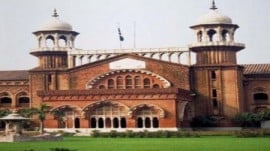With guests piling on the stairs in an auditorium filled beyond capacity, regional artists from across Pakistan serenaded the stage in a colourful, if belated Independence Day celebration hosted by the Pakistan National Council of the Arts (PNCA) on Tuesday.
PNCA Director General Tauqeer Nasir expressed pride brewing from the country’s rich heritage and culture, referring to it as a “colourful bouquet”, where each region was a unique colour and fragrance.
The evening was nothing short of his description, as the curtains were drawn to the sound of sweet Kashmiri folk tunes by a young and radiant Bano Rehmat. Clad in the phiran and ornate silver jewellery, she sang a folk number and a popular ghazal Sada hoon apne pyar kee. Her performance was followed by a traditional Kashmiri dance performed on celebratory occasions.
The next region, Khyber-Pakhtunkhwa (K-P) was met with a loud response as some Pakhtun members of the audience surrendered their seats to dance to the popular track, Bibi Shirin, which was performed by Ashraf Gulzar.
Nazneen Anwar, a new talent, though raw and sometimes off-key, was a welcome sight as she performed Pashto tunes about a woman’s burning desire for her lover. She was followed by the acclaimed artist Zasanga, who has been immersed in music for the past two decades. Her powerful vocal presence on stage has even earned her the coveted Pride of Performance award.
The PNCA dance troupe reappeared to perform the Khattak dance, though traditional swords used in the dance were replaced with friendlier red handkerchiefs.
Two young boys from the audience made it to the stage to mimic the Balochi Chaap as Akhtar Channal sang the popular Daane pe daana. The Balochi Leva performed again by the beaming and confident, PNCA dance group was a mesmerising show of subtle yet surprisingly seductive moves, a breath of fresh air in a society where any expression of sexuality is oppressed.
“Is he made in China?” joked an audience member as the host announced a “duplicate” of the renowned Sindhi Sufi artist, Allan Faqeer. Wahid Baksh, took to the stage, enchanting the audience with his soulful voice and unique expressions.
The Sindhi portion of the performances seemed to be a mini-me competition, as Abida Parveen’s student and carbon-copy, Samina Kanwal appeared — her posture, attire and unruly hair identical to Parveen. However, the young Kanwal lacked the same soul and charm — to belt out Mahi yaar dee ghadoli and Teray ishq nachaya.
The Sindhi jhoomar transitioned into the next, most populous region of Punjab. Last but not least, or perhaps intentionally underplayed for lack of any cultural mystery, Bhangra and dhol tunes by Fazal Jutt brought the evening to a unified end, as all the artists made a reappearance to sing Jeevay Pakistan, a contrived but hopeful way to show unity among the regions, in one blooming bouquet.
Published in The Express Tribune, August 30th, 2012.







1732617223-0/Untitled-design-(69)1732617223-0-270x192.webp)

1732622842-0/Express-Tribune-(9)1732622842-0-270x192.webp)







COMMENTS
Comments are moderated and generally will be posted if they are on-topic and not abusive.
For more information, please see our Comments FAQ